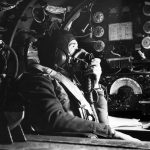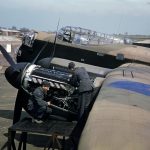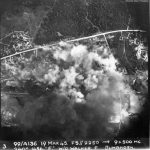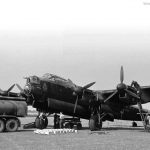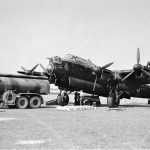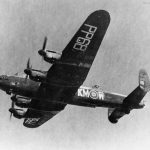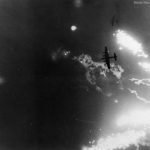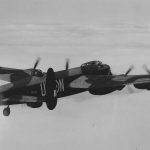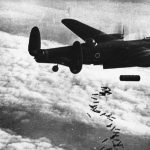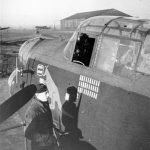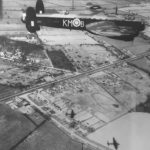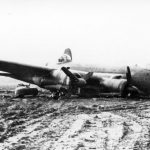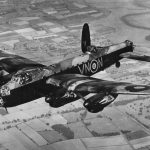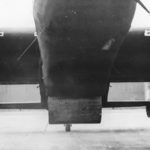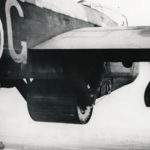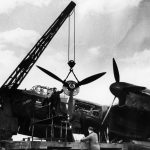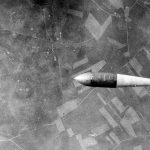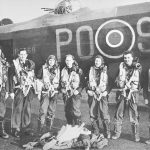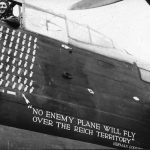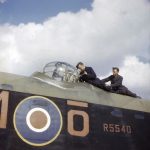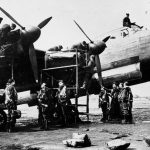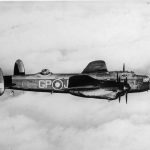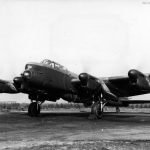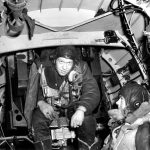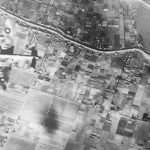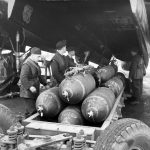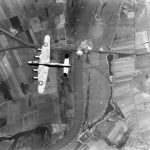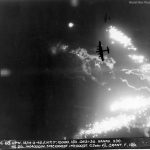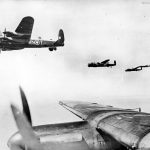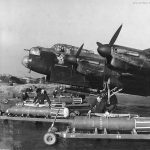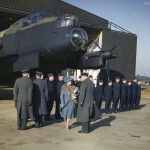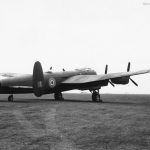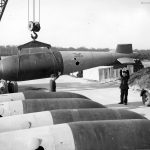Wing Commander Guy Gibson, John Searby and Peter Ward-Hunt
WAAF Steers 4000 lb Cookie under Bomb Bay of RAF Lancaster 1943
Testing the tyre pressure of Lancaster R5540 of No. 44 Squadron Conversion Flight at Waddington
Rear gunner of a Lancaster of No. 44 Squadron RAF
8000 lb Blockbuster Bomb, 1943
Mechanics work on the port engines of a Lancaster of No. 207 Squadron RAF
Wireless operator F/O Stewart with TR1154-55 set
Mechanics work on the port engines
Bomber with turret knocked off by a bomb
Squadron Leader Ronnie Churcher February 1944
Rose Turret with two U.S. light-barrel M2 Browning .50-calibre (12.7 mm)
Rose Turret with 2x M2 Browning heavy machine guns
Fraser Nash FN-20 tail turret
Lancaster raid on Jumbhorn 19 March 1945
Lancaster R5868 PO-S of No. 467 Squadron RAAF
Lancaster R5868 PO-S of No. 467 Squadron RAAF
Lancaster R5740 KM-O of No. 44 Squadron RAF at Waddington 29 September 1942
Lancaster R5733 2
Lancaster R5733
Lancaster Mk I R5727
Lancaster Prototype BT308 at Ringway January 1941
Lancaster R5620 of No. 83 Squadron RAF, Scampton 25 June 1942
Lancaster R5666 KM-F of No. 44 Squadron RAF October 1942
Lancaster Prototype BT308
Lancaster PP867 KM-W of No. 44 Squadron RAF 1945
Bomber pilot S/Ldr Churcher of No. 619 Squadron, 14 February 1944
Lancaster of Pathfinder Force lit by target Indicators
Lancaster ready for its next night mission, 16 February 1944
Lancaster NN696 57 Squadron RAF with H2S
Lancaster PD217 EM-Z Damaged in collision over Stuttgart 12-13 September 1944, East Kirkby
Lancaster PD235 UL-N of No. 576 Squadron RAF
Lancaster III ND648 Tiger Force Receiver Aircraft
Lancaster NG126 SR-B of No. 101 Squadron RAF during daylight raid on Duisburg 16th October 1944
Lancaster ND709 After 100th operation at Downham Market
Lancaster NG287 of No. 550 Squadron RAF
Lancaster Mk II DS689 of No. 426 Squadron RCAF
Lancaster ME844 LS-W of No. 15 Squadron RAF
Lancaster ME844 LS-C in flight
Lancaster low flying near Waddington February 1942,
Lancaster ME536 AL-Q of No. 429 Squadron RCAF and others of 100, 12 and 106 Sqs at Pomagliano in 1945
Lancaster ME649 460 Sqn RAAF 1944
Avro Lancaster loaded for food drop to Holland
Lancaster LM583 at RAF Waddington
Lancaster LM257 HA-P of No. 218 Squadron RAF
Lancaster Mk II LL669 of No. 514 Squadron RAF crashed at Leiston 17 March 1944
Lancaster KM-W of No. 44 Squadron RAF
Lancaster JB456 with Bristol B.17 turret
Lancaster JB456
Damaged Lancaster KM-J of No. 44 Squadron RAF damage after Peenemunde raid, 18 August 1943
Lancaster Mk I L7552 EK-C of No. 1656 HCU
Lancaster III with saddle tank for Far East missions
Lancaster III PB509 OJ-C of No. 149 Squadron RAF
Lancaster Mk III LM321 PH-H of No. 12 Squadron RAF 1943
Lancaster III PG-S of No. 619 Squadron RAF
Lancaster Mk II in flight
Lancaster I VN-N in flight
Lancaster flown by F/O W. Harris 9 Squadron RAF over Trossy St Maximin 1944
No. 619 Squadron RAF , 14 February 1944
W/Cdr Hopcroft with crew and Lancaster “Frederick II”
“Dambuster” ED932 AJ-G
“Dambuster” ED932 AJ-G
Lancaster ED860 QR-N after 100th operation 30 June 1944
Lancaster ED611 “Uncle Joe” of No. 463 Squadron RAAF
Lancaster ED588 VN-G of no. 50 Squadron RAF at Skellingthorpe
Lancaster named Dumbo
Lancaster DV236 SR-G of No. 101 Squadron RAF take off from Ludford Magna
Lancaster DV305 BQ-O of No. 550 Squadron RAF after Berlin Raid 30 January 1944
Lancaster DS604 of No. 61 Squadron RAF
Lancaster dropping Tallboy 19 June 1944
Crew with Lancaster B I R5868 May 1944
Lancaster B I R5868 PO-S of No. 467 Squadron RAAF
Lancaster B I R5868 2
Lancaster B I R5868 PO-S of No. 467 Squadron RAAF 4
Lancaster B I R5868 PO-S of No. 467 Squadron RAAF 3
Lancaster R5540 KM-O of No. 44 Squadron RAF
Lancaster R5540 KM-O of No. 44 Squadron RAF 3
Lancaster R5540 of No. 44 Squadron RAF
Bomb aimer in his position in the nose
Lancaster bomber 4
Lancaster bomber 3
Lancaster bomber 2
Lancaster bomber
Lancaster BI W4113 1661 HCU
Lancaster Barbara Mary
Lancaster being bombed up
Lancaster B.Mk I Special with Grand Slam 617 Sqn
Lancaster armourers 50 Sqn
Lancaster 619 Sqn Navigator feb44 2
Lancaster 619 Sqn feb44
Lancaster 617 Sqn
Lancaster 5 Group 220344 Frankfurt raid
Lancaster 57 Sqn Scampton 0443
Lancaster 550 Sqn take off for 100th op 4nov44
Lancaster 57 Sqn East Kirkby
Lancaster 431 Sqn RCAF Croft 1945
Lancaster of No. 115 Squadron RAF with tail shot off by two FW190s over Cologne 28 June 1943
Lancaster fuselages
Lancaster ZN-S of No. 106 Squadron RAF at Syerston May 1943
Lancaster of No. 106 Squadron RAF at Metheringham 1944
Lancasters Woodford
Bomber of No. 617 Squadron RAF over Arnsberg viaduct, Target was attacked successfully with 6 ‘Grand Slams’ on 19 March 1945.
Lancasters over Hanau 18/19 March 1945
Lancasters of No. 50 Squadron RAF in flight, color photo
Lancasters of No. 44 Squadron RAF in flight
Lancasters of No. 50 Squadron RAF in flight
Canadian Lancaster KB783 with bulged bombay and Glenn Martin dorsal turret
Guy Gibson Lancaster Mk I “ADMIRAL PRUNE” of No.106 Squadron. Avro Manchester L7434 in background 1942
George VI inspects ground crewmen lined up beneath the nose of Lancaster ED989 DX-F Frederick III
HM Queen Elizabeth inspecting flight and ground crews on a visit to Warboys, a station of No 8 Pathfinder Group Lancaster of No 156 Squadron
Canadian Lancaster KB783
75 Squadron Lancasters ready to take off
Woodhall Spa Grand Slam bomb dump of 617 Squadron RAF March 1945
Lancaster of No. 419 Squadron RCAF
“Margareth” -1000th completed “Lanc” at the Metro-Vick factory
History
Avro Lancaster – a heavy four-engine British World War II bomber plane, built at the A.V.Roe (Avro) factory, used since 1942. Next to the Handley Page Halifax aircraft, the Lancaster was the primary heavy bomber of the Royal Air Force during World War II. The Lancaster is considered to be the most successful British heavy bomber. A total of 7377 Avro Lancaster-type aircraft were manufactured.
The project was created from the development of the twin-engine heavy bomber Avro Manchester. Since the Rolls-Royce Vulture engines used in Manchester proved to be unreliable and underdeveloped, the aircraft was not fully successful and only 200 were built and withdrawn from combat use in 1942. Avro’s chief constructor, Roy Chadwick, then adapted the existing project to use four well known and proven Rolls-Royce Merlin engines. The result was the Avro type 683 four-engine bomber, initially named Manchester Mk. III and later Lancaster. The first flight of the prototype took place on 9 January 1941, the first serial bomber was built in October 1941.
The Lancaster bombers were built at Avro, Metropolitan-Vickers, Armstrong Whitworth, Vickers Armstrong and Victoria Aircraft (in Canada) in four very similar main serial versions: Mk. I, II, III and X, the most numerous of which were Mk. I and Mk. III. All bombing versions were preceded by the letter “B”, e.g. B. Mk. I, but it is often omitted. All versions except Mk. II were powered by Rolls-Royce Merlin engines. In total, by 2 February 1946, 7377 Lancasters were built.
One of the Lancaster’s advantages was a large bomb bay in the hull, 10.05 m long. The maximum load capacity of normal bomb versions was 6356 kg of bombs in various configurations. Initially, the heaviest bomb carried was the 1818 kg bomb. The Lancaster versions with a specially deepened bomb bay were carrying a heavy bomb of 3632 kg or a Tallboy bomb of 5448 kg. They were used to attack particularly important point targets. In 1945 a special version B was created. Mk. I (Special), with a cut-out bomb bay floor and removed part of the equipment, was designed to carry the heaviest bomb of World War II, Grand Slam, weighing 9979 kg. Another special version of the Lancaster, B. Mk. III (Special), was adapted in 1943 to carry Wallis’ bouncing bombs, designed to destroy dams in the Ruhr. The Lancaster had very good radio equipment, later the planes also had H2S radar for ground observation to facilitate targeting.
Variants:
Mk. I (B.Mk I) – basic version, powered by 1280 hp Rolls-Royce Merlin XX engines, and further production of Merlin 22, final Merlin 24. In 1943, H2S radar started to be installed. A total of 3425 units of this version were produced.
Mk. I (Special) – a special version was created in 1945 from rebuilding copies of version B. Mk. I, adapted to carry superheavy Grand Slam bombs weighing 9979 kg (22 000 pounds). They had an extended bomb bay, had no doors and were reinforced with floor stringers so that the plane could carry the bomb. Despite these modifications, the bomb was still protruding from the bomb bay and the plane looked as if it was carrying a torpedo. They were equipped with tuned Merlin 24 engines with propellers with blades bent like sabres and reinforced undercarriage. In order to reduce the aircraft’s own weight, the nose and dorsal turrets were removed, and the tail armament was reduced from 4 to 2 7.7 mm Brownings. The take-off weight with the Grand Slam bomb was 33,112 kg, the range was 2655 km and the maximum ceiling was 5180 m. From March to May 1945, 41 Grand Slam bombs were dropped. They were dropped between March and May 1945. 33 of these versions were made.
PR. I – version designed for photographic reconnaissance. All defensive weapons including turrets were removed, which resulted in the reconstruction of the nose of the machine. The cameras were installed in the bomb compartment. During the war it was used in No. 82 and 541 squadrons , and after the war in 683 in the Middle East.
Mk. I (FE) – a long-range version, designed for fighting in the Far East in tropical conditions. It was based on the last series of Mk. I versions. They had a nose turret FN5 and a tail turret FN82 with 2 12.7 mm MG. In addition, radio equipment, radar and an additional fuel tank of 400 gallons was installed in the bomb chamber. The upper surfaces of the machine were painted white and the bottom black. It did not take part in combat.
Mk. II – powered by air-cooled radial engines Bristol Hercules VI (power 1277 kW) – the first 27 pieces, and the others by version XVI (power 1270 kW). It was created due to shortages in the supply of RR Merlin engines. The prototype of this version was launched on 26 November 1941. 300 units were produced, since March 1942, at the Armstrong Whitworth plant, out of the 1000 units ordered. The first examples did not differ from the Mk. I version, but then modifications started. The curved door of the bombing compartment was mounted, which allowed to take the bomb load increased to 3628 kg, but still had a lower bomb load than the Mk. I version. Instead of the H2S radar, the G-H navigation and targeting device was started to be mounted, allowing for bombing in conditions of limited visibility. In place of the H2S radar on the bottom of the hull, the FN64 lower turret was mounted. The FN20 tail turret was replaced by the FN120, with a lighter design and a better target sight. Flame dampers were also installed on the engine exhaust pipes. This version had similar performance to Mk. I, with a better climb up to 5486 m, and above it, worse. Additionally, it had a lower ceiling than the Mk. I. version.
Mk. III – powered by American license engines Packard Merlin 28, Merlin 38 or Merlin 224 (3039 units).
Mk. III (Special) – modified in 1943 B. Mk. III from the 617th Squadron of the so-called “Dambusters” created to destroy dams. They carried transversely mounted, rotating left-handed bouncing bombs. For this purpose, the door of the bomb bay and additionally the dorsal turret were removed. A special device was installed to transmit the rotating motion of the bombs, even before their drop. In addition, lamps were installed in the bombing bay and under the nose to measure the height of flight above the surface. In this way 21 machines were rebuilt. During the action, in which finally 19 bombers took part, on 16/17 May 1943 three dams were destroyed, losing eight machines. After the action, the machines were rebuilt back to normal bombers.
A.S.R. III – a special version, for sea rescue. A radar was mounted on it and a boat was placed in the bombing bay to be dropped to the survivors. On these machines, the defence equipment was usually removed completely and additional observation windows were added to the hull.
Mk. VI – 9 Mk. III rebuilt in 1943, with Packard Merlin 85 engines. These engines had two-speed supercharger, which improved the ceiling and performance at high altitudes. They also removed the turret in the machine’s nose, mostly. They were used in 635 Sqn to mark the bomb drop area for bomber formations.
Mk. VII – 180 Mk. I planes rebuilt in 1945 with different weapons. On the back of the fuselage a Martin 250CE turret with 2 km 12.7 mm was mounted and moved further back, and in the tail a FN82 turret with 2 km 12.7 mm.
Mk. X (B. Mk. X) – a version built in Canada, with Packard Merlin 38 engines and then 224, with modified cabin equipment and modified electrical installation. On the last units turrets were mounted as in Mk. VII version. 430 units were built.
Mk. XPP – Mk. X rebuilt for passenger and mail planes. The turrets were removed, and an additional fuel tank (2 pieces) in the bombing compartment.
The Avro Lancaster planes were characterized by very good flying characteristics. Even the weaker versions of Mk. I and Mk. III were able, after a single engine failure, to reach the target with bombs and happily return to base. The forces on the rudders were small, the response to the steering was fast, the pilot was not exhausting, the stability was flawless, the visibility from the cabin was good. With the same power as the Handley Page Halifax, they carried a larger load of bombs, and reached a higher flight level. These features led Arthur Harris, RAF Bomber Command commander Arthur Harris, to refuse the use of this machine (e.g. towing transport gliders) other than for bombing strategic targets in Germany.
The Lancaster bombers joined the RAF in December 1941. New aircraft were the first to be equipped with the No. 44 Squadron RAF at Waddington. The four Lancaster planes were there on Christmas Eve 1941. On March 3, 1942, the Lancaster from this squadron carried out a mission in which he mined the German shipping lane near Heligoland. According to British doctrine, Lancaster was primarily a night bomber. The first combat flight of the 2 Lancasters was carried out on the night of April 17, 1942 during an air raid on Essen. They were then used en masse in successive RAF night raids on German cities and industrial facilities.
The famous and unusual action was to damage the dams in the Ruhr with Wallis’ bombs on May 19, 1943, by 617 Squadron. Another well-known action of the “Lanc” was the sinking of the German battleship “Tirpitz” with Tallboy bombs. The Lancaster planes carried out 156,000 combat operations during World War II, during which they dropped 608,612 tons of bombs. 3249 planes were lost in action, only 35 planes managed to complete more than 100 successful combat opera






